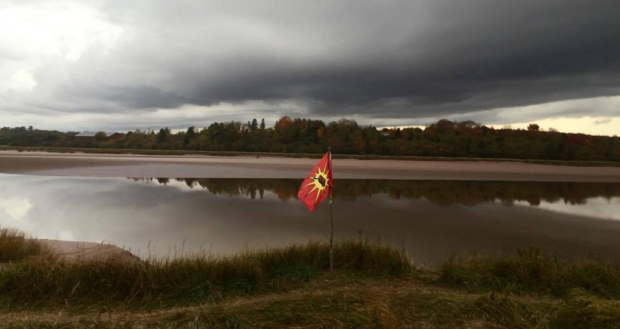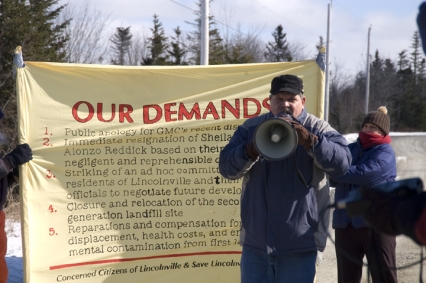KJIPUKTUK (Halifax) – Why are there so many garbage dumps close to African Nova Scotian communities? Why do Mi’kmaq communities experience food insecurity on their unceded territory? Who defines what counts as environmental racism?
The roots of environmental racism run pretty deep in Nova Scotia. About 500 years deep. On this episode of Shades of Green, we get curious about the forces that have shaped how we relate to the land and to each other here in unceded Mi’kmaq territory. Colonization has wrapped the histories of Mi’kmaq rights holders up with communities of Acadians, Scots, Black Loyalists, Maroons, Planters, and more recent immigrant communities. These displacements and migrations set the scene for the environmental racism that we see here today.
Before European colonizers arrived on these shores, Mi’kmaq communities had long been caring gently for these lands and waters. We talked to Roger Lewis about the violent disruption that colonial settlers brought with them. Roger is the Curator of Ethnology at the Nova Scotia Museum of Natural History and a member of Sipekne’katik First Nation: “Environmental racism, really, dates back to those Indian reserves. They go from the whole province of Nova Scotia to tiny reserves; from like 1,200 acres instead of 40,000 square miles. So they’re on the river in Shubenacadie because it’s the most productive area, and then all of a sudden they’re up in Shubenacadie (Reserve) with no access to rivers.”

Some European settlers brought enslaved African peoples to Mi’kma’ki. After the American Revolution, colonial governments also promised freedom, equality and land to Black Loyalists and other Black refugees coming northwards. Spoiler alert: these promises were broken. As activist and Lincolnville resident James Desmond described the origins of his small African Nova Scotian community: “(Black Loyalists) were promised land after they landed here, and were granted 3000 acres. But not too long after the French Acadians arrived and the 3000 acres was re-granted to the French Acadians. That was a loss of our good fertile land and our economic base because of the attachment to the fishery.”
In 1974, a large municipal dump opened one kilometre away from Lincolnville. Since then, the community has been concerned about the potential impacts of various contaminants, including cadmium, phenol, and toluene. When it closed in 2006, a large second-generation landfill almost immediately opened in the same location.

Sadly, Lincolnville’s experience is echoed across African Nova Scotian and Mi’kmaq communities. These disproportionate impacts are part of a larger racist pattern of displacement and blocked access to land and resources. El Jones’ poem Toxic Legacy connects these colonial histories with these environmental injustices. As she begins: “There’s a connection between the landfills / And our people’s being killed / Between environmental damage and our physical, spiritual, and mental damage / Whether from slavery, colonization, coloured homes or residential schools / And they think they can apologize and make it all better / Just like they think they can recycle and make it all better / There’s a relationship between continued pollution and their continued lack of solutions to racism and poverty / Because the problems lie at the root of settler society.”
We hope you’ll tune into episode two of our Shades of Green podcast series, “Toxic Legacy: Setting a Context for Environmental Racism in Nova Scotia.” Join us as we pull back and take a bit of a long view, exploring some of the histories of colonization on these lands and how these severed relationships with the land connect to the environmental racism we see today.
Featured Voices:
- Dr. Wanda Thomas Bernard
- James Desmond
- Jaden Dixon
- El Jones
- Lynn Jones
- Roger Lewis
- Barbara Low
- Catherine Martin
- Dr. Ingrid Waldron
Quotes have been condensed here for clarity and brevity. Huge thanks to every one of the ears and voices that made this episode possible. Further thanks to Erica Butler and Jen Graham.
Our theme was composed by the incredible Nick Durado. We are also grateful to Da Activiss for his amazing song Hellafactz.
This project has been supported by Ecology Action Centre and the Community Conservation Research Network
Subscribe on iTunes, SoundCloud, Stitcher, or Feedburner. And follow us on Twitter!
Further resources :
Sa’qewe’l kmitkinal: Ancestors Live Here
Lara Lewis: Welcome to Mi’kma’ki
Mi’kmaq resistance kept British holed up in their forts, historian finds
Elder Daniel Paul: Canada’s Shame- Centralization
Ni’newey Video Productions: A’se’k, the other room
Colonial Canada Had Slavery For More Than 200 Years. And Yes, It Still Matters Today
National Film Board: Remember Africa
Canadian Museum of Human Rights: The Story of Africville
CBC Information Morning NS: Environmental Racism – growing up in Lincolnville
A community of widows. The Shelburne dump and environmental racism
The ENRICH Project: Interactive, open-source, community-based map
Hilary Beaumont: Black Residents Say Nova Scotia Is Racist About Where It Dumps Its Trash
Brent Bundale: The toxic sites of Nova Scotia racism
Paul Levy: Let’s Spread the Word: Wetiko




Loving these podcasts! So informative for unaware settlers like myself, trying to learn. Thank you Sadie ❤